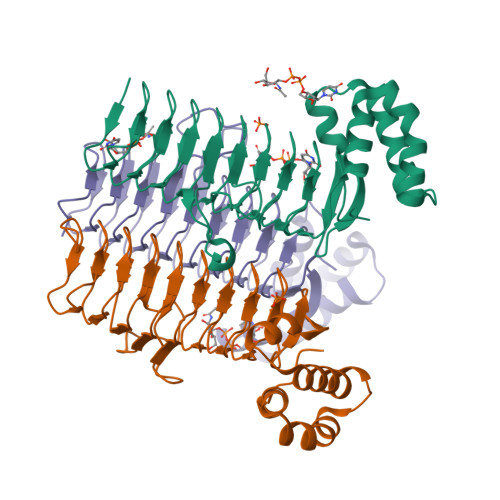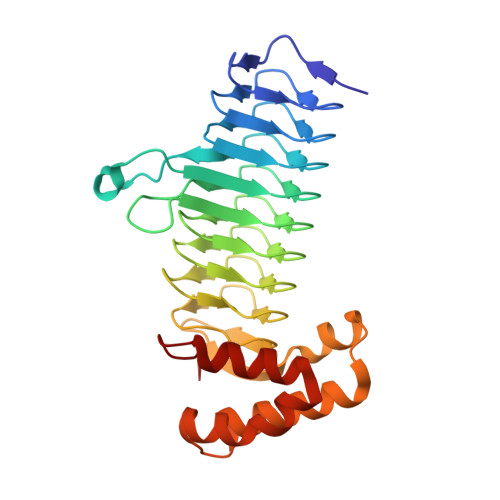Structures of Pseudomonas aeruginosa LpxA Reveal the Basis for Its Substrate Selectivity.
Smith, E.W., Zhang, X., Behzadi, C., Andrews, L.D., Cohen, F., Chen, Y.(2015) Biochemistry 54: 5937-5948
- PubMed: 26352800
- DOI: https://doi.org/10.1021/acs.biochem.5b00720
- Primary Citation of Related Structures:
5DEM, 5DEP, 5DG3 - PubMed Abstract:
In Gram-negative bacteria, the first step of lipid A biosynthesis is catalyzed by UDP-N-acetylglucosamine acyltransferase (LpxA) through the transfer of a R-3-hydroxyacyl chain from the acyl carrier protein (ACP) to the 3-hydroxyl group of UDP-GlcNAc. Previous studies suggest that LpxA is a critical determinant of the acyl chain length found in lipid A, which varies among species of bacteria. In Escherichia coli and Leptospira interrogans, LpxA prefers to incorporate longer R-3-hydroxyacyl chains (C14 and C12, respectively), whereas in Pseudomonas aeruginosa, the enzyme is selective for R-3-hydroxydecanoyl, a 10-hydrocarbon long acyl chain. We now report three P. aeruginosa LpxA crystal structures: apo protein, substrate complex with UDP-GlcNAc, and product complex with UDP-3-O-(R-3-hydroxydecanoyl)-GlcNAc. A comparison between the apo form and complexes identifies key residues that position UDP-GlcNAc appropriately for catalysis and supports the role of catalytic His121 in activating the UDP-GlcNAc 3-hydroxyl group for nucleophilic attack during the reaction. The product-complex structure, for the first time, offers structural insights into how Met169 serves to constrain the length of the acyl chain and thus functions as the so-called hydrocarbon ruler. Furthermore, compared with ortholog LpxA structures, the purported oxyanion hole, formed by the backbone amide group of Gly139, displays a different conformation in P. aeruginosa LpxA, which suggests flexibility of this structural feature important for catalysis and the potential need for substrate-induced conformational change in catalysis. Taken together, the three structures provide valuable insights into P. aeruginosa LpxA catalysis and substrate specificity as well as templates for future inhibitor discovery.
Organizational Affiliation:
Department of Molecular Medicine, University of South Florida , 12901 Bruce B. Downs Boulevard, Tampa, Florida 33612, United States.



















